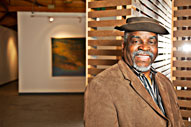
Metro Detroit is one of the largest contemporary art markets in the country, according to George N'Namdi, founder of the N'Namdi Center for Contemporary Art, a visual and performing arts venue housing one of the world's finest collections of African American art. This week George writes about the guest curators and artists who are turning Detroit's Sugar Hill arts district into a showpiece of the modern art circuit.
Post 4: The Creative Corridor
Posted By: George N'Namdi
Posted: 1/17/2011
Detroit houses a corridor filled with creative industries, and this could attract more businesses and tourists to the city by growing knowledge of this corridor that runs along Woodward. We will ease the navigation of the area by referring to it and the districts that it encompasses by a specific name. I would propose we brand it as The Creative Corridor.
Richard Florida, author of the global best-seller The Rise of the Creative Class, says that a creative economy is a must for a city's revitalization, and this corridor along Woodward has one of the densest groupings of creative industries in the state as well one of the most diverse. What better way to reference an area that has so many cultural, art, medical, technological, and educational industries.
Mapping the Creative Corridor
The Creative Corridor begins at Woodward and West Grand Blvd. and runs to Woodward and Jefferson. The area encompasses New Center and Tech Town, then Midtown (the cultural center) followed by Fox Town, downtown Campus Martius, and finally, Hart Plaza. The major institutions in the North Corridor are Henry Ford Health System, state of Michigan offices, and the Detroit Public Schools headquarters.
The Midtown section houses the College for Creative Studies, Wayne State University and the Detroit Medical Center. Also found in Midtown are many museums including the Detroit Institute of Art, the Charles H. Wright Museum of African American History, MOCAD and the N'Namdi Center for Contemporary Art, and many other institutions and galleries. The lower half of Midtown has The Max M. Fisher and Bonstelle Theatre and ends with The Fox Theatre, which is also where the sports and entertainment district start with Ford Field, Comerica Park and The Fillmore. The South Corridor is showcased by Compuware, Campus Martius Park, the Coleman Young Building and Hart Plaza. It's important to realize all of this is along a short four-mile stretch of Woodward.
I frequently make the walk from West Grand Blvd to the river and I see more and more people out running and cycling, a sign that people are treating the area as a place not just for work and play, but as a place to live. As more and more people are making their residence here, it further drives art and cultural businesses like galleries. As more galleries are successful, they help drive nearby businesses like boutiques and restaurants.
How It Brings Business
The districts within the Creative Corridor would still keep their identities but from a marketing perspective it makes sense to encompass them all under one name when wooing potential businesses looking to move into Detroit. Much like other cities have branded what they have to offer, like Silicon Valley in California or the Automation Alley in Oakland County, Detroit should focus on the existing industries here. Unlike these other economic districts offering only one area of expertise, the corridor offers a diverse amount of experienced professionals to entrepreneurs and established business owners alike. By branding all our creative proficiency together, we can target many types of creative businesses in a succinct way.
How It Drives Tourism
When using the corridor in branding to tourists, I feel that Woodward serves as a mental rail for visitors until light rail arrives (and yes, it is coming). It gives an easy reference point for all the major hot spots. Where is the Book Cadillac? Why, it's 2 blocks west of Woodward at Campus Martius. By branding the ease of navigating the downtown area, we'll provide tourists with the confidence they need to get around.
There are many ways we can brand the Creative Corridor to tourists, but to start, I feel we should be better utilizing the Pure Michigan ad campaign. This campaign has proven itself effective in attracting visitors from other states and I would hope they'd use that power to affect Detroit in a positive way. Currently they focus much of their time on the shores and up North. By fully showcasing the Creative Corridor and the ease of navigating it, I believe people would be planning their Detroit vacations.
The Creative Corridor is a major asset and driving force for the region. It is has poised Detroit for a comeback, and now it is on us to get the word out.